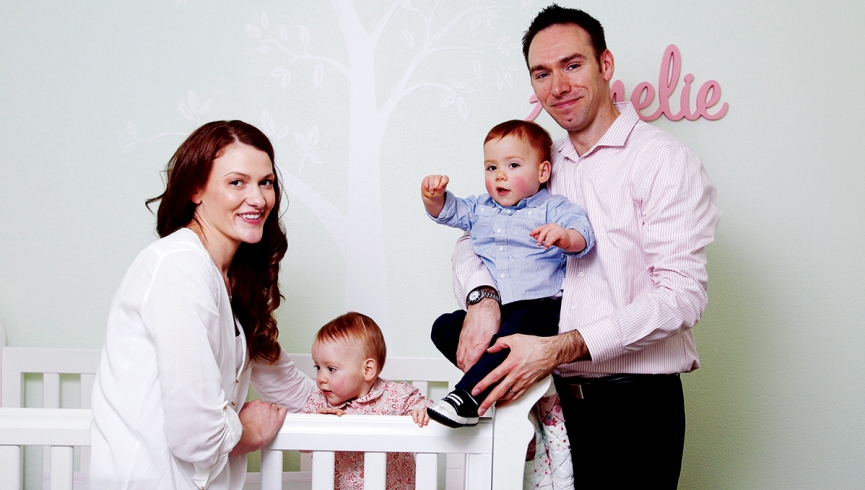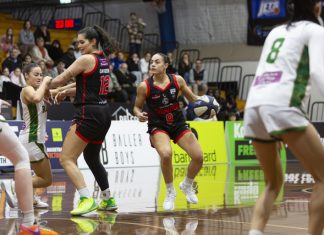Conceiving naturally doesn’t always go to plan. Melissa Cunningham and Stephanie Zevenbergen report on how IVF is changing the lives of people in Melbourne’s west, one baby at a time.
WALKING through the front door of Danielle Toselli’s Sunbury home, it’s evident children live here. There are toys on the floor and two little boys play and laugh in the lounge room.
Lachlan is four and Brody is two.
It sounds like a cliche, but Toselli will tell any person struggling to conceive to never give up hope.
In 2005, newly married Toselli and her husband, Frederic, decided they wanted a family But it didn’t go to plan.
They were referred to Melbourne IVF in 2006.
“It was overwhelming, it was just so much to take in,” Toselli says. “I think back to then, when IVF was really a taboo – people didn’t talk about it. It was really difficult. We just had to rely on each other.”
The couple put their hopes into 19 of Toselli’s eggs, but none of them resulted in a baby.
“It was devastating – I remember crying in the lifts at the hospital,” she says.
“It’s just one of those things where you feel so out of control … no matter how much you want it and how much you’re willing to pay, there’s just nothing you can do about it.”
Toselli estimates IVF cost the couple about $10,000.
“We would have sold our house to have children,” she says.
“We didn’t care – whatever it cost, we managed to find the money.”
Six months after trying IVF with no success the couple turned to Chinese medicine as an alternative.
That didn’t work, either.
So they decided to take a break from trying to conceive and soon gave up hope on ever having children.
“We put our house on the market and decided that we were going to buy where we wanted to live, build a big house, have a big debt and just live for our material things because we wouldn’t have children of our own,” Toselli says.
Two weeks after the “for sale” sign went up outside their house, Toselli discovered she was pregnant.
“It was weird, very surreal and confusing,” she says.
To this day, she’s not sure if it was the hormones from IVF or the Chinese medicine, but one way or another she conceived two children naturally.
According to Monash IVF, for most couples pregnancy occurs naturally within 12 months of trying to conceive. But for up to 20 per cent of couples it’s a different story; they keep trying and nothing happens or they achieve pregnancy only to miscarry.
In Sunshine, Gareth Weston is responsible for the births of more than 500 babies.
The Sunshine Monash IVF clinical director and fertility specialist says the best part of his job is seeing a positive result.
“I enjoy seeing the glee on the patients’ faces when they achieve success – it’s a very great privilege,” he says. “We have many patients that come back to visit us … that has got to be what keeps you going.”
Weston has worked in Sunshine since the clinic was built in 2008. He enjoys the “multicultural flavour” of patients in the west but says it does bring unique challenges.
“It presents its own challenges, particularly with religious and cultural differences,” he says. “We’re proud to say we treat all religious cultures and deal with their needs.
“At the moment, Monash is having a major sperm drive to try to meet a desperate need. In particular, we struggle if multicultural patients want multicultural sperm.”
After 13 failed attempts to get pregnant through IVF, Leah Neill and Dallas Fishley had almost given up on the dream of having a family.
Over seven years of seeking treatment through the Monash IVF clinic, the couple endured 12 negative results and one positive. In the latter case, within six weeks Neill had lost the baby.
“It was extremely disheartening,” she says. “By the eighth, ninth and 10th time I began to think, why are we doing this? We aren’t getting anywhere. It was one heartbreak after another. The whole process consumes you.
“Emotionally, I was up and down all the time due to the effects the hormones were having on my body.
‘‘The strain it put on our marriage was enormous.”
There was no reason for the couple’s infertility, experts dubbing it “unexplained infertility”.
“I think that was one of the most frustrating parts – that we didn’t know why it was happening or how to fix it,” Neill, 36, says.
She says one of the hardest parts was hearing about the pregnancies of the women around her.
“Of course you are happy when your friends and family fall pregnant, but there is a part of you that wonders why it isn’t happening for you,” she says. “I was on very strong hormones … everything revolved around making sure I injected myself with my hormones at the right time every day.”
After spending thousands of dollars on IVF, in 2010 the couple decided to take a year-long break from the process.
“Our family had been so supportive, even lending us money for the medical costs, but we decided we’d had enough,” she says. “We began to look into adoption but the process in Australia meant we would be waiting up to seven years for a baby, and even then it was not guaranteed.
‘‘If we decided to adopt, it would also mean we had to completely stop IVF.”
Neill says she refused to give up hope and in 2011 they recommenced IVF.
“Our last round of IVF, I think I had began to stop thinking about the process so much,” she says. “I cut out the acupuncture, I ate what I wanted, I kept living my life and it was during that time I fell pregnant.”
By the end of the year, she was pregnant with twins.
“We went in for the 12-week scan and the doctor said, ‘There’s the heartbeat … and there’s the other one’,” she says. “We were shocked we were having twins but elated. We had our instant family.”
Months after she fell pregnant, Neill’s mother died from cancer.
“It was devastating but it was bittersweet because she knew before she passed away that we were having twins,” she says.
At 24 weeks, Neill was rushed to hospital. She had a shortened cervix and was made to have strict bed rest until the twins were born.
“At 24 weeks their chance of survival was very slim as they were both very small and their organs were still developing,” she says.
“We had to make a call – if I went into labour – whether or not they would be resuscitated.”
Six weeks later, Amelie and Noah were born weighing 1.2 and 1.4 kilograms respectively. They had open heart valves and would spend more than two months in hospital.
Inside their Ascot Vale home photos of the family take pride of place amid an organised collection of children’s toys.
“They bring me sleep deprivation, joy and happiness every day,” Neill says with a laugh.
“The first moment holding them in my arms made it all worthwhile. But it was a long, hard process that almost broke us. Almost.”








